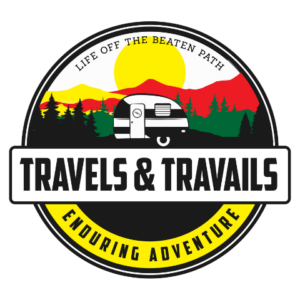I love living off the land on a long, dispersed camping expedition. It’s good for the soul to take a break from technology and cleanse your spirit of the hustle culture we’re constantly embroiled in.
The only part of the boondocking experience I and many dispersed campers don’t like is showering. How in the world are you supposed to do it?
Here are my favorite showering hacks for dispersed campers:
- Water bottle and sponge
- Electric camping shower
- Lake showering
- Pocket shower
- Tank shower
- Solar shower
- Propane shower
- Public shower
As you can see, you have no shortage of options for maintaining hygiene when on your next dispersed camping expedition. Join me as I delve into all the practicalities of showering in the middle of nowhere.
How Long Can You Reasonably Go Without Showering?
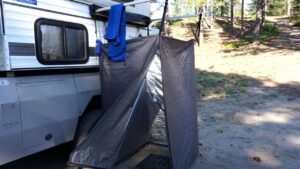
I could go on for days about the benefits of dispersed camping. It’s quiet. You feel like you have all the time in the world. You’ll have real, meaningful conversations without the distractions of email and social media notifications.
Best of all, you’ll finally put your smartphone down. It will feel weird at first but freeing soon after.
However, hygiene is a big concern when dispersed camping. You can’t expect to shower daily. You’re purposefully venturing away from known campgrounds and state or national parks, so you don’t have the access to shower facilities most campers do.
Everyone has different comfort levels regarding when it’s time to shower. You might not mind waiting three or four days, or perhaps your skin crawls at the thought of going more than 48 hours without standing under running water.
Keep in mind that your decision isn’t only about you. You must consider the others around you. They don’t want to smell you any more than you want to smell them, so be considerate to your fellow campers, especially those you’re sharing an RV or travel trailer with.
Squeaky Clean: 8 Showering Options for Dispersed Campers
You’ve determined it’s high time for a shower. Although not always glamorous, you have many options for bathing yourself during your dispersed camping trip. Let’s explore each, including some pros and cons.
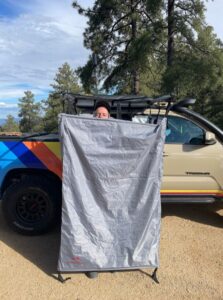
1. Water Bottle and Sponge
Beginning with the simplest option, you only need two things to clean yourself this way: a sponge and a water bottle. Well, you’ll also probably want some shampoo, conditioner, and body wash.
This method is ultra-simple. Find a private area where no one can see you (or use a shower tent), strip down, pour some water on your body, lather up, and use the water to rinse off. Alternatively, you can moisten a sponge and wipe yourself down.
Called a sponge bath or cat bath, this is a good in-between option if you’re only a little grungy and eager for a refresh.
You can go through a lot of water bottles bathing yourself, so ensure you don’t dip into your potable water supply much and that you and each of your passengers still have a sufficient amount to drink.
Whenever you bathe in nature, please use environmentally friendly, biodegradable products. The runoff you create when bathing will make its way into lakes, streams, and oceans and can affect the wildlife that calls it home.
Here’s another tip: have a towel ready so you can quickly dry off. A microfiber towel is ultra-absorbent and will get you dry fast. That comes in handy for drying your hair, as you won’t have an outlet to plug in your trusty blow dryer.
2. Electric Camping Shower
Your next option is an electric camping shower. As the name implies, these showering systems rely on one or more batteries. The batteries typically detach and can be charged via a USB port or a charging cable.
While it varies depending on the option you select, the batteries can provide at least 60 minutes of use, sometimes double that. That should give you and your passengers more than enough time to take a decently long shower before recharging the battery for tomorrow.
An electric camping shower includes a hose, shower head, and pump. The pump must be submerged in water before you turn on the battery. Once it’s running, the pump will purify the water from the shower head.
Many shower heads included with electric camping showers are detachable, so you can thoroughly wash yourself and get all the grime off. Electric showers should conform to safety standards to ensure safe usage every time you bathe.
Some electric camping showers include a carrying bag with your purchase, and if not, it’s easy enough to shop for one separately.
It all sounds pretty great, right? So, what’s the downside?
Well, you’ll recall that you need a bathing solution for dispersed camping. You might not have a campsite around for miles, which means your access to USB plugs and electric outlets is sparse at best and nonexistent at worst.
You could have the best showering solution in the world, but if you can’t use it, it doesn’t do you any good.
3. Lake Showering
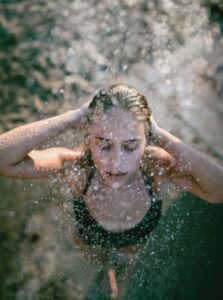
Your next option is simpler and should be readily available wherever your adventures take you when dispersed camping. Shower in a lake or stream.
You must find a time when the lake isn’t widely in use to take your bath. Depending on local decency laws, you can potentially strip down. You might consider wearing a swimsuit for modesty and privacy, but make sure you clean what’s underneath.
I recommend a lake over a river or stream, as you don’t have to contend with a current. There’s no need to go super deep into the water to shower. A few feet out will do. Wet yourself, lather up, and rinse off.
I want to reiterate the importance of using biodegradable, eco-friendly bathing products in a river or lake, as the runoff is immediate. Even then, please use your products sparingly to avoid seriously contaminating the water.
There are a few safety concerns to consider when bathing in a lake. I wouldn’t recommend doing it at night, as you could stumble and end up in deep water, where you could potentially drown.
I wouldn’t suggest lake bathing at all if you can’t swim. A lake won’t have a lifeguard, so you’re on your own out there. At the very least, have someone else in the area so you have backup if you need it.
Another risk, although low, is the brain-eating bacteria known to live in bodies of water across the nation. If you go underwater and it gets into your nasal passages or mouth, it could reach your brain, where it’s often fatal.
4. Pocket Shower
You should certainly consider a pocket shower, as it’s one of the most portable options for keeping clean. Often made of nylon, pocket showers earned that name because they fit right in your pocket, be that a pants pocket or a pouch in your backpack.
These showers can hold varying amounts of water, determining how much bathing time you get. For example, a 10-liter pocket shower should give you seven minutes’ worth of water, which isn’t as much as an electric shower.
However, pocket showers don’t need electricity, and since you might not have any to come by, that makes this style of shower more efficient for dispersed camping.
Pocket showers are usually made of high-quality nylon with a good denier count. The seams are often taped or otherwise sealed.
I suggest a black pocket shower, as the color of the fabric allows it to absorb heat, so you have warm water.
The pocket shower should include graduated apertures to ensure an even water spray and a twist mechanism for setting the degree of flow and turning off the water.
When you’re not using this shower solution, you can flatten it, fold it in your backpack, and be on your merry way. It also doubles as a sleeping bag or dry sack, so it’s versatile.
5. Tank Shower
On the opposite end of the spectrum is the tank shower. This system includes a tank that you will fill with water, as the name alludes. Since the tank is designed for portability, it usually holds under a gallon of water.
That’s still more than you get in a pocket shower, so it should suffice for everyday showering. Most tanks of that size produce enough water for 15 minutes of showering, but it depends on the flow rate.
Tank showers include internal heating systems that can warm up the water. The level of warmth you get varies, but it can be up to 95 degrees Fahrenheit, more than hot enough for a shower. You should have a control valve for adjusting the water flow rate and temperature.
You can pour hot water straight into the tank or allow the tank to heat up cold or lukewarm water. This can take anywhere from 15 to 45 minutes, depending on the model and the water temperature.
Some tank showers include an attached sponge for scrubbing away the day’s grime. Sophisticated models will include water level sensors and LED lights on the dashboard indicating how much water is left and when the water in the tank has reached the optimal temperature.
There are several downsides to tank showers. One is their weight, as they weigh several pounds apiece. They’re not very portable and carrying them can be a struggle.
You also need a 12-volt power source to use a tank shower, which plugs into your car, truck, motorhome, or camper and uses battery power. The long power cord, while a safety feature to keep the cord dry, also presents a tripping hazard.
6. Solar Shower
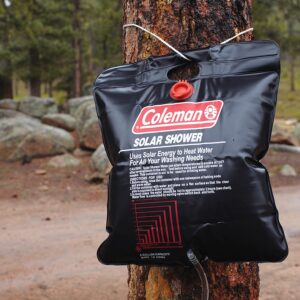
If you like the style of a pocket or bag shower, wait until you see solar showers. This efficient, portable shower comes in a bag.
Using a solar shower is exceptionally easy. Place the bag or reservoir in a sunny area, and it’s heat-locking material will collect solar energy to ensure warm showers. The amount of available water in the reservoir varies but can be up to five gallons. That should be more than enough for your whole crew to shower.
If you’re traveling just you and a partner or friend, five gallons of water should be enough for several showers.
Filling the reservoir is effortless. Pour in clean water and tightly secure the cap when you’re finished. Many solar showers have on/off valves for controlling water flow and conserving H2O.
Yours might even include a built-in carrying handle for easy transportation.
Like a pocket shower, solar showers compress easily and go into your backpack when not in use. However, the stylized design of these portable showers precludes you from using them for other purposes.
Another downside is that you must have a stretch of sunny weather to use a solar shower. Otherwise, expect cold water.
7. Propane Shower
You can always rely on a propane shower to stay clean during dispersed camping expeditions. A propane shower is a tankless, portable solution that can hold several liters of water at once.
Better yet, many models are battery-powered, so you don’t have to worry about having access to electricity.
Pour in the propane and ignite. The water in the shower reservoir will warm up, so you can have a hot shower even when hundreds or thousands of miles from home.
Many propane showers include temperature and flow rate specifications, allowing you to adjust both for your comfort.
While propane showers are one of the most sophisticated options at your disposal, they also carry some downsides. Although tankless, propane showers are quite heavy, perhaps more so than all the solutions we’ve looked at.
It’s not uncommon for propane showers to weigh 10 pounds. They don’t compress in any way, so you’re stuck lugging around this big, heavy system just to have a warm shower when there are more portable, convenient options out there.
You also have to work with propane, igniting it. That can be dangerous if not done properly. Buying a propane shower means committing to keeping a propane supply in your RV. You must be careful where you store the tanks for weight distribution and fire safety purposes.
Propane is highly flammable, so keep it away from heat sources.
8. Public Shower

I saved the most ideal but least attainable option for last, and that’s using a public shower. Campsites, truck stops, gyms, state parks, recreation centers, and national parks are some options where shower facilities are available.
If you find these spots on your route, you can pull in, stop for a while, and take a shower. You will have to bring your own supplies such as body wash, shampoo, conditioner, a loofah, and a shaving razor, but you won’t have to stress about water flow or temperature.
You might have to pay to use these facilities, so read up on the public space before you drive there.
Hygiene Hacks to Extend Your Time Between Showers
Showering when dispensed camping won’t happen every day, just to make that point abundantly clear. The following tips will help you fight off grime so you can skip showering for several days and not feel disgusting.
Choose Your Clothing Materials Carefully
Breathable materials are best. Merino wool is one of my favorite materials for camping. It wicks away moisture, dries quickly, and contains lanolin, which prevents the accumulation of odors.
You’re not supposed to launder merino wool often, which is why it’s called washless. You can go five or seven wears of the same item before it’s time for the washing machine, making it perfect for dispensed camping.
You can buy merino wool everything, from socks to pants, shirts, and underwear. The only downside? It’s an expensive fabric. You could experience sticker shock if you’re used to buying cotton garments.
Alternate Your Outfits
While you can wear some fabrics like merino wool several days in a row, don’t if you don’t have to. You’ll feel fresher alternating your clothes. Bring at least two of the same pieces, such as shirts or pants, and switch every other day.
Do Some Basic Laundering
If you don’t have the room to bring too many clothes, make an effort to clean what you’ve got when you’re not wearing it. You can wash your items with water and some soap, but using just water is better than nothing.
Try to clean your clothes daily if you can’t shower for a while. It will help.
Bottom Line
You have many options for maintaining your cleanliness while dispersed camping in your RV. At the very least, you can give yourself a sponge bath or use a water bottle to stay clean. At most, you can set up shop with a solar shower or propane shower.
Remember to always be a responsible camper, using eco-friendly products, cleaning up any messes you make, and respecting our beautiful planet!
